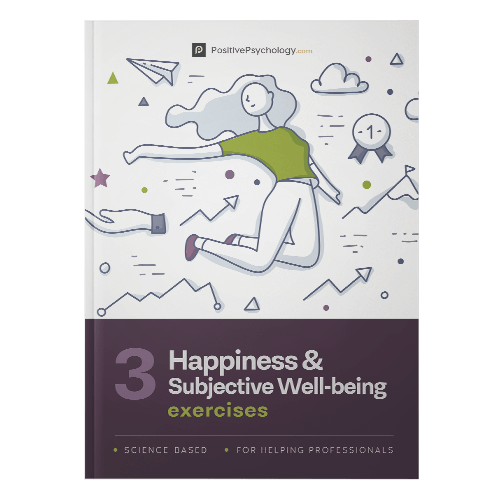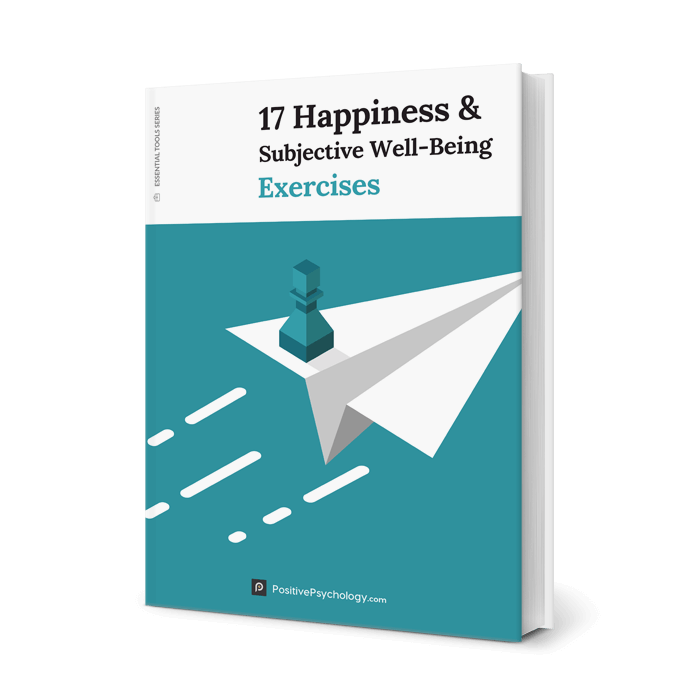How to Find True Happiness (According to Psychology)
 What does it mean to be truly happy?
What does it mean to be truly happy?
There are many philosophical schools of thought regarding the concept of happiness and its cultivation.
For instance, the pursuit of enduring happiness is at the core of many mindfulness practices, which often emphasize gratitude and seeking contentment in the present moment.
Other models of happiness suggest the importance of living in congruence with our values and in ways that satisfy our basic human needs. Some research even shows that whether we are happy or not can, in part, be boiled down to our genetics.
In what follows, we’ll walk you through several conceptualizations of happiness, show you how to measure each, and give you a wide range of strategies for cultivating whichever form of happiness you seek in your own life.
Before you continue, we thought you might like to download our three Happiness & Subjective Wellbeing Exercises for free. These detailed, science-based exercises will help you or your clients identify sources of authentic happiness and strategies to boost wellbeing.
This Article Contains:
What is Happiness?
Defining happiness is no small task, but philosophers and researchers have drilled the notion down to two key conceptualizations.
These conceptualizations are known as hedonia and eudaimonia, and together, they represent two long-running traditions in the study of happiness that stem as far back as the times of ancient philosophers (Ryan & Deci, 2001).
Happiness as hedonia
The hedonic perspective of happiness argues that life’s goal is to experience the maximum amount of pleasure and the minimum amount of pain. According to this tradition, how happy we are can be boiled down to the sum of one’s total hedonic moments (Ryan & Deci, 2001).
When it comes to measuring hedonic happiness, modern psychologists tend to use assessments of Subjective Wellbeing (see How to Measure Happiness below; Diener & Lucas, 1999).
In the past, philosophers of hedonism adopted a fairly narrow view of pleasure and pain related to bodily sensations, appetites, and self-interests. Examples of such forms of hedonia include eating tasty food, enjoying sex, and being free of physical discomfort.
Today, psychologists adopting the hedonic view take an interest in both the pleasures of the body and mind in the broader study of wellbeing (Kahneman, 1999).
This broader, more psychological conceptualization of hedonic pleasure argues that happiness can flow from behaviors that promote mental stimulation, stress relief, feelings of social connectedness, positive mood, and more (Arnold & Reynolds, 2003).
This expanded conceptualization has resulted in the broadening of the study of hedonic pleasure to fields such as economics. For instance, hedonic conceptualizations of happiness are used to understand how shoppers make decisions between purchases, estimating how much pleasure or utility they stand to gain by choosing one product over another (Babin, Darden & Griffin, 1994).
Happiness as eudaimonia
The eudaimonic perspective of happiness presents an alternative to the hedonic view, arguing that true happiness is found when one behaves virtuously. Pursuing eudaimonia, therefore, is about doing what is worth doing.
In line with this, we can think about the eudaimonic perspective as being about reaching one’s true potential and living in congruence with one’s values and true self. It also involves developing one’s talents and strengthening relationships with those for whom we care. By living in this way, one should feel deeply engaged and fully alive (Waterman, 1993).
When it comes to measuring eudaimonic happiness, most researchers tend to use Ryff and Keyes’ (1995) multidimensional scales of psychological wellbeing (see How to Measure Happiness below).
According to the eudaimonic perspective, that which feels pleasurable is not always conducive to wellbeing. Likewise, that which is worth doing does not always feel pleasurable in the present moment.
For instance, volunteering for a cause one feels passionate about may not always feel pleasurable in the hedonic sense. It may involve spending long hours sweating in the sun, getting dirty, or dealing with challenging people or situations. Nonetheless, such pursuits may feed into our eudaimonic happiness as we live in unity with our values.
Interestingly, many traditional philosophers who championed the eudaimonic perspective denounced hedonic views of happiness, declaring them vulgar and overly self-centered. For instance, Aristotle considered hedonic happiness to make humans slavish followers of frivolous desires.
Spiritual conceptualizations of happiness
Today, we can consider a third perspective of happiness which lies in the practice of mindfulness.
Whereas the previous two perspectives consider happiness as something that must be sought, growing schools of thought argue that happiness in the form of contentment or inner peace are primarily available to us at any given moment, regardless of what we are doing.
Consider the following quote from neuroscientist and mindfulness practitioner Sam Harris (2014):
Most of us spend our time seeking happiness and security without acknowledging the underlying purpose of our search. Each of us is looking for a path back to the present: We are trying to find good enough reasons to be satisfied now.
Acknowledging that this is the structure of the game we are playing allows us to play it differently. How we pay attention to the present moment largely determines the character of our experience and, therefore, the quality of our lives.
– Sam Harris, Waking Up, p. 3
Mindfulness-based perspectives on happiness and contentment have traditionally been a feature of eastern religions. These traditions hold the view that there exists a source of psychological wellbeing that is not dependent on gratifying one’s desires (hedonia) or pursuing an integrated, self-actualized sense of self (eudaimonia).
Rather, happiness can be achieved by cultivating present-moment awareness and self-transcendence. In other words, these arguments suggest that it is possible to give up the search for happiness and commit oneself to finding contentment in what is happening right now.
A rapidly growing body of psychological and neuroscientific evidence has emerged to support these claims (Hanson, 2009), pointing us toward another avenue for cultivating sustainable happiness.
Overall, happiness is likely to look different for different people. As an individual or practitioner, you may find the most value in considering how all three of these conceptualizations factor into you or your client’s life as a first step toward cultivating enduring happiness.
How to Measure Happiness

As noted, hedonic conceptualizations of happiness are often measured using assessments of subjective wellbeing (Diener & Lucas, 1999). Subjective wellbeing regards a person’s cognitive and affective evaluations of his or her life (Diener, 2000).
You can read more about measures of subjective well-being in our other dedicated articles. In these, we explore several commonly accepted measures of hedonic happiness. These include:
- The Positive and Negative Affect Schedule (Watson, Clark & Tellegen, 1988);
- The Satisfaction with Life Scale (Diener, Emmons, Larsen & Griffin, 1985); and
- The Global Happiness Scale (Lyubomirsky & Lepper, 1999)
When it comes to assessing eudaimonic happiness, most scholars apply Ryff and Keyes’ (1995) multidimensional measure of psychological wellbeing (PWB).
The creators’ development of the measure was spurred by their observation that previous studies had treated happiness as synonymous with a balance between positive and negative affect or overall satisfaction with one’s life.
They argued that these approaches were too data-driven and not rooted in theory or lived experience. Therefore, these scholars designed and validated a measure based on responses from a representative sample of telephone interviews (Ryff & Keyes, 1995).
This measure assesses eudaimonic happiness according to six sub-dimensions:
- Autonomy
The ability to resist social pressures, regulate behavior from within, and evaluate oneself based on personal standards. - Environmental mastery
Feelings of mastery and competence in a variety of situations, the ability to take advantage of opportunities, and the ability to craft one’s environment to suit one’s needs and values. - Personal growth
Feelings of ongoing development, the realization of one’s potential, and observing oneself changing in ways that signify acquired knowledge and increased effectiveness. - Positive relations with others
Possessing warm, trusting relationships with others characterized by give and take, and the capacity for intimacy and empathy. - Purpose in life
Having goals and a sense of meaning and belief that gives life purpose. - Self-acceptance
Possessing a positive attitude toward oneself, including both one’s good and bad qualities.
Two versions of this scale are available. The first is the original 42-item measure (Ryff, 1989a; 1989b), and there is also a shortened 18-item version (Ryff & Keyes, 1995).
You can find the items for both of these scales, as well as scale anchors and scoring information on Stanford University’s website.
For another useful tool that attempts to reconcile the hedonic and eudaimonic perspectives of happiness, take a look at Hervás and Vázquez’s (2013) Pemberton Happiness Index (PHI).
Upon recognizing that existing assessments of happiness measured either hedonic or eudaimonic conceptualizations of happiness, these scholars sought to design and validate a brief, comprehensive measure that assessed both.
The final 21-item scale also has the advantage of capturing both remembered and experienced wellbeing (Kahneman & Riis, 2005).
The former relies on participants’ memory and judgment about their overall lives, using items like, “I feel able to solve the majority of my daily problems.” In contrast, the latter assesses real-time affective states and feelings about the previous day, using items like, “I learned something interesting.”
As for assessing happiness flowing from conceptualizations in mindfulness, many researchers have administered short scales that capture momentary changes in emotions via diary study.
The purpose of a diary study is to assess fluctuations in states (e.g., moods, thoughts, etc.) throughout a given day. This type of study design, sometimes called a within-person design, runs contrary to many studies in psychology, which typically compare differences between people.
As an example, Diener and colleagues (2010) designed the 12-item Scale of Positive and Negative Experience (SPANE), which was designed to be quickly administered and assess the full range of emotions and feelings a person may experience. The scale, therefore, contains both general and specific emotional terms, such as “pleasant” and “sad.”
Thanks to its brevity, this scale can easily be administered multiple times a day. Therefore, it has been applied in diary studies assessing fluctuations in mindfulness throughout a day. For instance, Ding and colleagues (2019) used the scale in a study examining the link between state mindfulness and present-moment emotions.
The results indicated that state mindfulness was positively related to positive emotions, like happiness and contentment, and negatively related to negative emotions, like depression and boredom.
These authors also found that present-moment rumination, which involves fixation on negative thoughts, partially mediated this effect. In other words, maintaining a mindful state of awareness appears to block ruminative thought partially, helping us to enjoy more positive emotions throughout any given day.
In sum, it’s clear psychologists have done much of the heavy lifting when it comes to developing measures of happiness.
As a practitioner looking to assess your clients’ happiness, you should use the information above as a guide to ensure the content validity of your chosen measure. That is, take care to select a scale that has been shown to effectively assess the conceptualization of happiness (e.g., hedonic, eudaimonic) that you apply in your practice.
Neurological measures of happiness
You may have noticed that the measures of happiness discussed so far have all been self-report in nature. That is, each relies on participants providing information about their own subjective sense of their happiness.
But is there a more objective way to measure happiness?
To answer this question, philosophers and psychologists have been turning to neuroscience to better understand what happiness looks like in the brain.
This research has involved the use of sophisticated technologies, such as PET and fMRI scans, and EEG measures of electrical activity in the brain to identify how happiness manifests physiologically. (Murphy, Nimmo-Smith & Lawrence, 2003; Phan, Wager, Taylor & Liberzon, 2002; Lindquist, Wager, Kober, Bliss-Moreau & Barrett, 2012)
We also see a growing wealth of research on how neurotransmitters like dopamine and serotonin play into our day-to-day experience of happiness. We will consider these more closely in the later sections as levers for strengthening our overall happiness.
What is True Happiness?
To recap, we now have three conceptualizations of happiness: hedonia, eudaimonia, and contentment rooted in mindfulness.
We also have two ways to measure each form of happiness: self-reports and various physiological indicators in the brain.
But the question remains: Is there a secret to finding true happiness?
What has hopefully become apparent is that this question is somewhat of a trick question because there is no agreed-upon understanding of what constitutes ‘true’ happiness.
Think about it.
Imagine racing to your favorite Mexican restaurant and arriving at the ordering counter moments before the restaurant is about to close. The server takes your order, and a few minutes later, you’re handed your favorite taco.
What action would a scholar of each ‘happiness philosophy’ recommend at this moment when you receive your meal?
To a believer of hedonism, happiness would likely represent the moment you bite into the taco and delight in its flavors on your tongue.
To philosophers of the eudaimonic perspective, happiness would more likely involve the ritual of eating with someone you care about, thereby strengthening your connection with that person. It could also mean reaching your potential as a budding cook by learning to create a similarly tasty dish or giving the taco to someone hungry and in need.
Finally, followers of the mindfulness-based perspective would argue that contentment can be found in any or all of the above actions but that it is the quality of your attention, paid to your intentions, sensations, emotions, and interactions with others, that would dictate the happiness you derived from whatever you chose to do with the taco.
In sum, these examples indicate that searching for one ‘true’ source of happiness may be feeding into a fallacy. Rather, there appear to be several pathways to pursuing different sources of happiness.
The remainder of this article will outline scientifically evidenced pathways to cultivating each of these three forms of happiness.
But before setting off on your search, heed one warning…
The Wrong Way to Search for Happiness

There are at least three critical bodies of theory, thinking, and research that point to why sacrificing life’s present joy’s chasing happiness is likely to make us paradoxically more miserable.
We have already touched on the first perspective, which is based on the philosophy of mindfulness.
This perspective encourages us to give up the search for happiness entirely, harness our attention, and discover that contentment that can exist in stillness, no matter what we yearn for or have yet to achieve (Harris, 2014).
According to this perspective, by failing to acknowledge that contentment is available to us at any given moment, we will remain dissatisfied. This is because even if we achieve all our goals and get everything we want, some newer, shinier source of happiness will always arise for us to chase.
In other words, the grass will always appear greener somewhere else, meaning it is important to look for happiness wherever we are presently standing.
The second body of thinking lies in empirical findings from the psychology of expectancies and goal-pursuit.
One study in the journal, Emotion (Mauss, Tamir, Anderson & Savino, 2011), found that those who reported valuing happiness highly experienced greater disappointment and ultimately less happiness when circumstances that should have made them happy failed to meet their expectations. In other words, the findings paradoxically suggest that the more we desire happiness, the less likely we are to experience it.
Likewise, there is evidence that placing too much importance on achieving challenging goals in the distant future may also be a recipe for misery.
One study found that students who perceived they made poor progress toward their ambitious life goals tended to exhibit significant depressive symptoms two years later (Salmela-Aro & Nurmi, 1996). Moreover, the study evidenced a downward spiral of depressive symptoms; disappointed students proceeded to derive less enjoyment from their goal pursuits, thereby worsening their symptoms.
Together, these findings highlight the danger of hanging all our hopes for being happy on the realization of future events.
A third reason why chasing happiness may be a mistake relates to a process known as hedonic adaptation (or the hedonic treadmill). Hedonic adaptation is the observed tendency of humans to quickly adapt to a baseline level of happiness, regardless of significant life events (Brickman & Campbell, 1971).
Indeed, it has been shown that even if one wins a major lottery, the happiness that person derives from day-to-day activities in life will eventually return to baseline (Brickman, Coates & Janoff-Bulman, 1978).
This finding highlights that we should not overestimate the effect that significant life events will have on our long-term happiness, serving as yet another reason to call off the search for happiness (Grant, 2013).
In sum, it is important to recognize that happiness is not somewhere off in the distance. There is always something to be gained by pausing to reflect on our reasons to be happy right now, such as by practicing gratitude.
We will explore this and several other strategies to find hedonic, eudaimonic, and present-moment happiness in the remaining sections.
You don’t find happiness, you create it – Katarina Blom
7 Ways to Find Happiness
You now understand a key pitfall to avoid in your search for happiness. Next, let’s consider eight different sources of happiness you can leverage today to find joy in your own life.
Finding happiness through neurotransmitters
The first effective way to boost hedonic happiness is to engage in healthy behaviors that directly target neurotransmitters associated with pleasure.
While there are many neurotransmitters that affect our happiness, there are a few key ones worth focusing on: dopamine, serotonin, oxytocin, and endorphins.
Dopamine, otherwise known as the “feel-good” hormone, is a key feature of the brain’s reward system and associated with pleasure. Dopamine can be triggered in many ways, including through exercise, a healthy diet, sufficient sleep, listening to music, meditating, and ensuring you get a little sunlight each day (Breuning, 2015; Hansen, Stevens & Coast, 2001).
Next is serotonin. This hormone plays an essential role in stabilizing our mood and can be triggered in many of the same ways as dopamine, such as by getting consistent sleep, exercise, and ensuring you maintain a balanced diet (Breuning, 2015; Roman, Walstra, Luiten & Meerlo, 2005).
Third is oxytocin, which is the hormone associated with love, bonding, and close connection. This hormone is boosted primarily through physical touch and closeness with others, meaning that hugs, cuddling, and even simply spending time with others can significantly increase our happiness (Breuning, 2015; Uvnäs-Moberg, Handlin & Petersson, 2015).
The final neurotransmitters to consider are endorphins, which reduce physical pain and act as your body’s natural reward system. To increase this hormone, try engaging in behaviors that are ‘good’ for you, such as exercising or demonstrating sincere acts of kindness (Breuning, 2015). Studies have also shown that consuming cocoa, such as that in dark chocolate, can trigger endorphins in the brain (Ottley, 2000).
This was just a brief snapshot into the neurochemical bases of happiness.
To learn more and gain a range of practical tips to naturally boost your neurochemical happiness, take a look at Dr. Loretta Breuning’s book, Habits of a Happy Brain.
Finding happiness through real goods
A next important step in the search for happiness is to work toward securing the basic necessities for wellbeing and development, or what Aristotle called real goods.
Real goods satisfy the natural needs of our bodies, such as our needs for warmth and sustenance. Examples of such real goods include food, clothing, health, shelter, and safety (Moss, 2012).
We might liken this conceptualization to that of the lower levels of Maslow’s hierarchy, which argues that humans must satisfy basic physiological and safety-related needs before pursuing higher-order needs like esteem and self-actualization.
However, real goods also include “goods of the soul,” such as love, arts, music, and literature (Joseph, 2019). These goods clearly tap into the higher levels of Maslow’s hierarchy, and without them, it may be challenging to achieve eudaimonic happiness.
For instance, without a secure shelter in which to gain adequate rest, we would likely lack the energy to develop a new talent, such as painting. Nor would we gain this talent without exposure to sources of inspiration, such as other artists’ work or cultural influences.
In sum, Aristotle’s principles regarding real goods highlight two courses of action for improving happiness.
First, take steps toward securing the basics for your health and wellbeing. This means eating well, engaging in regular exercise, securing a stable income, and getting plenty of sleep.
Secondly, immerse yourself in environments that will bring out your best. For example, surround yourself with good company, knowledge, and cultures. In practice, this may mean stepping outside your comfort zone by meeting new people, learning new skills, or visiting new places.
Finding happiness through gratitude
Many studies stemming from the eudaimonic and mindfulness-based perspectives point to the practice of gratitude as a key source of happiness.
Gratitude can be defined as “the appreciation of what is valuable and meaningful to oneself… [representing] a general state of thankfulness and/or appreciation” (Sansone & Sansone, 2010, p. 18).
Two simple ways to practice gratitude include taking a moment at the end of the day to reflect on an occurrence for which you were grateful and sending a thoughtful message of appreciation to someone you care about.
For more ideas, take a look at some of our dedicated articles on this topic:
- 13 Most Popular Gratitude Exercises & Activities
- 41+ Gratitude Messages, Letters and Lists
- How To Express Gratitude to Others (19 Ideas + Gifts & Challenges)
- Gratitude Journal: A Collection of 66 Templates, Ideas, and Apps for Your Diary
Finding happiness through flow
Another way to achieve happiness is to take part in activities that bring about the experience of flow, otherwise known as the feeling of “being in the zone.”
In an interview, Mihaly Csikszentmihalyi, the researcher credited with having popularized the concept of flow, explained that those in a state of flow are:
…completely involved in an activity for its own sake. The ego falls away. Time flies. Every action, movement, and thought follows inevitably from the previous one, like playing jazz. Your whole being is involved, and you’re using your skills to the utmost.
(Geirland, 1996)
Examples of just a few activities that can generate flow include games, sports, dancing, cooking, gardening, work, driving, and artistic pursuits (Csikszentmihalyi, 1990).
Most followers of the eudaimonic perspective would view the flow experience as an indicator of eudaimonia. This is because flow experiences entail an optimal level of challenge, enabling us to develop our talents to their fullest (Csikszentmihalyi, 1990).
For more ideas on how to cultivate flow in your life, look at our dedicated articles on the topic:
- The Psychology and Theory Behind Flow
- 11 Activities and Exercises to Induce a Flow State (+ 6 Examples)
- What is Flow in Psychology? Definition and 10+ Activities to Induce Flow
- Flow at Work: The Science of Engagement and Optimal Performance
Finding happiness by living into our values
Several studies have found that making intentional efforts to live in congruence with our values can bolster our happiness or at least buffer against unhappiness (Brown, 2018; Veage et al., 2014).
For clarity, we can define values as “stable, general beliefs about what is desirable” (Feather, 1992, p. 111). Examples of values include fairness, creativity, and freedom.
Understanding our values is critical to achieving eudaimonic happiness because the eudaimonic perspective of happiness encourages us to engage in what is worth doing (Boniwell, 2008). In order to know what is worth doing, we must understand which actions generate valued outcomes, and we can only know this by looking closely at our core values.
Scientists and practitioners have developed a range of useful exercises to help individuals discover their core values. You can learn more about these in several of our other articles:
- 25 Values Worksheets to Enrich Your Clients’ Lives With More Meaning
- The 3 Best Questionnaires for Measuring Values
- Values Clarification: How Reflection On Core Values Is Used In CBT
Once you are clear on your core values, you can take steps to behave in a way that is congruent with these values, helping you live a happier life.
For instance, if you discover that one of your core values is growth, you might then consider the different ways to enact this value in day-to-day life. This could involve registering for a night class or pursuing new intellectual pursuits through reading.
Research also shows that the alignment between our values and professional pursuits plays an important role in determining our overall happiness (Chatman, 1989; Kristof-Brown, Zimmerman & Johnson, 2005).
Based on this, we see the emergence of research on job crafting, which involves altering one’s work to better align it with our preferences (Zhang & Parker, 2019), and that on hiring practices that facilitate good person-job fit (Sekiguchi, 2004).
Therefore, organizational leaders and HR professionals may wish to dig further into some of these concepts to strengthen the happiness of their staff.
Finding happiness through needs satisfaction
One prominent theory of happiness posits that to be happy, we must engage in behaviors that satisfy our three core human needs (Ryan & Deci, 2008):
- the need for competence (feeling effective);
- the need for autonomy (the feeling of being the origin of one’s behavior); and
- the need for psychological relatedness (feeling cared for and understood by other people).
Overall, the satisfaction of these needs represents an avenue for achieving happiness that falls under the eudaimonic conceptualization. This is because need satisfaction promotes long-term wellness rather than just temporary pleasure (Boniwell, 2008).
For a simple assessment to determine your overall satisfaction of core needs within your life, consider completing the 21-item Basic Needs Satisfaction in General Scale (BNSG-S; Gagné, 2003).
Upon completing the assessment, one can calculate their total score for each core need and identify an area for growth as a first step toward fostering greater eudaimonic happiness.
For instance, if you discover that your lowest-scoring need is competence, you might consider whether you can engage in work or hobbies that better utilize your skills, enabling you to derive a greater sense of competence from daily activities.
Again, this was just a brief snapshot into the science of needs satisfaction as a mechanism for achieving happiness. To learn more, look at our dedicated article on self-determination.
Finding happiness through mindfulness
Finally, and at the core of the mindfulness-based approach to finding happiness is the practice of mindfulness itself.
Mindfulness is typically defined as the practice of bringing one’s attention to the internal and external experiences occurring in the present moment, such as sensations, sights, thoughts, and emotions (Baer, 2003; Kabat-Zinn, 1994).
Mindfulness has existed for centuries and was first popularized among eastern traditions. The practice functions to better understand feelings and motivations, train the capacity for attention and relaxation, and free one’s mind from overidentification with negative thoughts and emotions (Fronsdal, 2004; 2006; Harris, 2014).
Often, regular meditation will lie at the core of mindfulness practice. However, other approaches to developing mindfulness can include journaling and yoga.
No matter how you practice mindfulness, the aim is typically for the practice’s benefits to spill over into your experience of day-to-day consciousness, enabling you to return to states of mindful awareness throughout your day and not be at the whim of negative thoughts and emotions.
If you’re interested in cultivating greater happiness through mindfulness, we have a range of articles throughout our blog to help you learn more:
- Mindfulness Meditation Videos, Exercises, Books and Courses (+PDF)
- How To Practice Mindfulness: 10 Practical Steps and Tips
- Practicing Mindfulness in Groups: 9 Activities and Exercises
- 18 Mindfulness Games, Worksheets and Activities for Kids
3 Tips to Form Habits for Happiness

As with any behavior change, becoming happier requires that one form new, positive habits. For instance, if you wish to target happiness through neurotransmitters like dopamine and serotonin, a first step may be to develop routines and habits associated with good sleep and regular exercise.
Likewise, if you wish to cultivate happiness through regular gratitude practice, commit to setting aside fifteen minutes each evening to fill in a gratitude journal.
Here are three tips related to the science of habit formation to help you develop your new habits for happiness.
First, set a goal to strengthen your happiness using a goal-setting framework. By using a framework to set a happiness goal, you can avoid accidentally setting a goal that is too vague, easily track your progress, and rest assured knowing your goal is realistic and within your reach.
Second, keep in mind that it takes approximately two months for a new behavior to become an automatic habit (Lally, van Jaarsveld, Potts & Wardle, 2010), so do whatever it takes to commit to your goal for at least this long.
That way, you can see if your new practice has enduring benefits and becomes easier with time. For instance, you may find you need to set daily reminders for yourself (e.g., to journal, settle in for bed) for a couple of months until your new habit becomes automatic.
Finally, consider linking up with a friend or small group and commit to becoming happier together. In the same way that groups like AA and Weight Watchers can help their members develop better habits associated with health, you can work with others to stay accountable and get support if you face any hurdles in your pursuit of greater happiness.
A Take-Home Message
The aim of cultivating human happiness is at the core of positive psychology.
It should, therefore, be no surprise that we have linked to many of our other posts exploring different approaches to fostering happiness throughout our discussion.
Now that you hopefully have a better sense of what you’re searching for when thinking about your own happiness, as well as pitfalls to avoid, we encourage you to select one area for growth. Once you’ve chosen an area, follow the links to read more and commit to developing one new habit for happiness.
By doing this, you’re letting go of the false conception of ‘true’ happiness as something elusive and far off in the future. Instead, you’ll be acknowledging happiness as something that can be achieved little-by-little, right now.
And if you ever find yourself getting lost in your search for happiness, consider reflecting on this famous quote:
Happiness is a journey, not a destination; happiness is to be found along the way not at the end of the road, for then the journey is over and it’s too late. The time for happiness is today not tomorrow.
Paul H. Dunn
We hope you enjoyed reading this article. Don’t forget to download our three Happiness Exercises for free.
- Arnold, M. J., & Reynolds, K. E. (2003). Hedonic shopping motivations. Journal of Retailing, 79(2), 77-95.
- Babin, B. J., Darden, W. R., & Griffin, M. (1994). Work and/or fun: Measuring hedonic and utilitarian shopping value. Journal of Consumer Research, 20(4), 644-656.
- Baer, R. A. (2003). Mindfulness training as a clinical intervention: A conceptual and empirical review. Clinical psychology: Science and Practice, 10(2), 125-143.
- Boniwell, I. (2008). What is eudaimonia? The concept of eudaimonic well-being and happiness. Retrieved from http://positivepsychology.org.uk/the-concept-of-eudaimonic-well-being/
- Breuning, L. G. (2015). Habits of a happy brain: Retrain your brain to boost your serotonin, dopamine, oxytocin, & endorphin levels. Avon, MA: Simon and Schuster.
- Brickman, P., & Campbell, D. T. (1971). Hedonic relativism and planning the good society. In M. H. Appley (Ed.), Adaptation-level theory (pp. 287–302). New York, NY: Academic Press.
- Brickman, P., Coates, D., & Janoff-Bulman, R. (1978). Lottery winners and accident victims: Is happiness relative? Journal of Personality and Social Psychology, 36(8), 917-927.
- Brown, B. (2018). Dare to lead: Brave work. Tough conversations. Whole hearts. London, UK: Vermilion.
- Chatman J. A. (1989). Improving interactional organizational research: A model of person–organization fit. Academy of Management Review, 14(3), 333-349.
- Csikszentmihalyi, M. (1990). Flow: The psychology of optimal experience. New York, NY: Harper & Row.
- Diener, E. (2000). Subjective well-being: The science of happiness and a proposal for a national index. American Psychologist, 55(1), 34-43.
- Diener, E. D., Emmons, R. A., Larsen, R. J., & Griffin, S. (1985). The satisfaction with life scale. Journal of Personality Assessment, 49(1), 71-75.
- Diener, E., & Lucas, R. E. (1999). Personality and subjective well-being. In D. Kahneman, E. Diener, & N. Schwarz (Eds.), Well-being: The foundations of hedonic psychology (pp. 213–229). New York, NY: Russell Sage Foundation.
- Diener, E., Wirtz, D., Tov, W., Kim-Prieto, C., Choi, D. W., Oishi, S., & Biswas-Diener, R. (2010). New well-being measures: Short scales to assess flourishing and positive and negative feelings. Social Indicators Research, 97(2), 143-156.
- Ding, X., Du, J., Zhou, Y., An, Y., Xu, W., & Zhang, N. (2019). State mindfulness, rumination, and emotions in daily life: An ambulatory assessment study. Asian Journal of Social Psychology, 22(4), 369-377.
- Feather, N. T. (1992). Values, valences, expectations, and actions. Journal of Social Issues, 48(2), 109–124.
- Fronsdal, G. (2004). Not-Knowing. Insight Meditation Center. Retrieved from https://www.insightmeditationcenter.org/books-articles/articles/not-knowing/.
- Fronsdal, G. (2006). Mindfulness meditation as a Buddhist practice. Insight Meditation Center. Retrieved from https://www.insightmeditationcenter.org/books-articles/articles/mindfulness-meditation-as-a-buddhist-practice/.
- Gagné, M. (2003). The role of autonomy support and autonomy orientation in prosocial behavior engagement. Motivation and Emotion, 27(3), 199-223.
- Geirland, J. (1996). Go with the flow. Wired. Retrieved from https://www.wired.com/1996/09/czik/
- Grant, A. (2013). Does trying to be happy make us unhappy? Psychology Today. Retrieved from https://www.psychologytoday.com/us/blog/give-and-take/201305/does-trying-be-happy-make-us-unhappy
- Hansen, C. J., Stevens, L. C., & Coast, J. R. (2001). Exercise duration and mood state: How much is enough to feel better? Health Psychology, 20(4), 267-275.
- Hanson, R. (2009). Buddha’s brain: The practical neuroscience of happiness, love, and wisdom. Oakland, CA: New Harbinger Publications.
- Harris, S. (2014). Waking up: A guide to spirituality without religion. New York, NY: Simon and Schuster.
- Hervás, G., & Vázquez, C. (2013). Construction and validation of a measure of integrative well-being in seven languages: The Pemberton Happiness Index. Health and Quality of Life Outcomes, 11(1), 1-13.
- Joseph, S. (2019). What is eudaimonic happiness? How and why positive psychologists are learning from Aristotle. Psychology Today. Retrieved from https://www.psychologytoday.com/au/blog/what-doesnt-kill-us/201901/what-is-eudaimonic-happiness
- Kabat-Zinn, J. (1994). Wherever you go, there you are: Mindfulness meditation in everyday life. New York, NY: Hyperion.
- Kahneman, D. (1999). Objective happiness. Well-being: The foundations of hedonic psychology, 3(25), 1-23.
- Kahneman, D., & Riis, J. (2005). Living and thinking about it: Two perspectives on life. In F. Huppert, N. Baylis & B. Kaverne (Eds.), The science of well-being (pp. 285-306). New York, NY: Oxford University Press.
- Kristof‐Brown, A. L., Zimmerman, R. D., & Johnson, E. C. (2005). Consequences of individuals’ fit at work: A meta‐analysis of person-job, person-organization, person-group, and person-supervisor fit. Personnel Psychology, 58(2), 281-342.
- Lally, P., van Jaarsveld, C. H., Potts, H. W., & Wardle, J. (2010). How are habits formed: Modelling habit formation in the real world. European Journal of Social Psychology, 40(6), 998-1009.
- Lindquist, K. A., Wager, T. D., Kober, H., Bliss-Moreau, E., & Barrett, L. F. (2012). The brain basis of emotion: A meta-analytic review. The Behavioral and Brain Sciences, 35(3), 121-143.
- Lyubomirsky, S., & Lepper, H. S. (1999). A measure of subjective happiness: Preliminary reliability and construct validation. Social Indicators Research, 46(2), 137-155.
- Mauss, I. B., Tamir, M., Anderson, C. L., & Savino, N. S. (2011). Can seeking happiness make people unhappy? Paradoxical effects of valuing happiness. Emotion, 11(4), 807-815.
- Moss, J. (2012). Aristotle on the apparent good: Perception, phantasia, thought, and desire. Oxford, UK: Oxford University Press.
- Murphy, F. C., Nimmo-Smith, I. A. N., & Lawrence, A. D. (2003). Functional neuroanatomy of emotions: A meta-analysis. Cognitive, Affective, & Behavioral Neuroscience, 3(3), 207-233.
- Ottley, C. (2000). Food and mood. Mental Health Practice, 4(4), 46-52.
- Phan, K. L., Wager, T., Taylor, S. F., & Liberzon, I. (2002). Functional neuroanatomy of emotion: A meta-analysis of emotion activation studies in PET and fMRI. Neuroimage, 16(2), 331-348.
- Roman, V., Walstra, I., Luiten, P. G., & Meerlo, P. (2005). Too little sleep gradually desensitizes the serotonin 1A receptor system. Sleep, 28(12), 1505-1510.
- Ryan, R. M., & Deci, E. L. (2001). On happiness and human potentials: A review of research on hedonic and eudaimonic well-being. Annual Review of Psychology, 52(1), 141-166.
- Ryan, R. M., & Deci, E. L. (2008). Self-determination theory and the role of basic psychological needs in personality and the organization of behavior. In O. P. John, R. W. Robins, & L. A. Pervin (Eds.), Handbook of personality: Theory and research (p. 654–678). New York, NY: The Guilford Press.
- Ryff, C. D. (1989a). Beyond Ponce de Leon and life satisfaction: New directions in quest of successful ageing. International Journal of Behavioral Development, 12(1), 35-55.
- Ryff, C. D. (1989b). Happiness is everything, or is it? Explorations on the meaning of psychological well-being. Journal of Personality and Social Psychology, 57(6), 1069-1081.
- Ryff, C. D., & Keyes, C. L. M. (1995). The structure of psychological well-being revisited. Journal of Personality and Social Psychology, 69(4), 719-727.
- Salmela-Aro, K., & Nurmi, J. E. (1996). Depressive symptoms and personal project appraisals: A cross-lagged longitudinal study. Personality and Individual Differences, 21(3), 373-381.
- Sansone, R. A., & Sansone, L. A. (2010). Gratitude and well being. Psychiatry, 7(11), 18-22.
- Sekiguchi, T. (2004). Person-organization fit and person-job fit in employee selection: A review of the literature. Osaka Keidai Ronshu, 54(6), 179-196.
- Uvnäs-Moberg, K., Handlin, L., & Petersson, M. (2015). Self-soothing behaviors with particular reference to oxytocin release induced by non-noxious sensory stimulation. Frontiers in Psychology, 5.
- Veage, S., Ciarrochi, J., Deane, F. P., Andresen, R., Oades, L. G., & Crowe, T. P. (2014). Value congruence, importance and success and in the workplace: Links with well-being and burnout amongst mental health practitioners. Journal of Contextual Behavioral Science, 3(4), 258-264.
- Waterman, A. S. (1993). Two conceptions of happiness: Contrasts of personal expressiveness (eudaimonia) and hedonic enjoyment. Journal of Personality and Social Psychology, 64(4), 678-691.
- Watson, D., Clark, L. A., & Tellegen, A. (1988). Development and validation of brief measures of positive and negative affect: the PANAS scales. Journal of Personality and Social Psychology, 54(6), 1063-1070.
- Zhang, F., & Parker, S. K. (2019). Reorienting job crafting research: A hierarchical structure of job crafting concepts and integrative review. Journal of Organizational Behavior, 40(2), 126-146.
Let us know your thoughts
Read other articles by their category
- Body & Brain (49)
- Coaching & Application (57)
- Compassion (26)
- Counseling (51)
- Emotional Intelligence (24)
- Gratitude (18)
- Grief & Bereavement (21)
- Happiness & SWB (40)
- Meaning & Values (26)
- Meditation (20)
- Mindfulness (45)
- Motivation & Goals (45)
- Optimism & Mindset (34)
- Positive CBT (28)
- Positive Communication (20)
- Positive Education (47)
- Positive Emotions (32)
- Positive Leadership (18)
- Positive Parenting (4)
- Positive Psychology (33)
- Positive Workplace (37)
- Productivity (16)
- Relationships (46)
- Resilience & Coping (36)
- Self Awareness (21)
- Self Esteem (38)
- Strengths & Virtues (31)
- Stress & Burnout Prevention (34)
- Theory & Books (46)
- Therapy Exercises (37)
- Types of Therapy (64)





What our readers think
Everyone has to realize that every person is going thru their own thing, every single person is different very different from one another. just because a person is learning something doing something at the same time as u does not mean they are disappointed at u also learning it the same time but rather are shocked because they thought of u as something bigger knowing it all.
So just explain something that u went thru different from that person not to compare but to rather say u know dude/dudette I know I may seem big but I am I just was lost all my life and it makes me, however, feel privileged that I’m going thru the same thing as yourself though, it means a lot.
Hi i want to quickly share my story how i get rid of anxieties, not being happy and knowing who i am so it can help someone. I was looking for someting to fullfill my heart and be happy during my growing up i was searching all over internet and trying all the stuff. I was so despered that i even went to psychiatrist and psychologist so i tried that but nothing helped me. I went into spiritual teaching from buddhism to all the other and even shamanic ceremonies but still didnt found answers and fell more and more down. I felt like i really need change and new life.
Then on youtube i found video from “last reformation” it shows followers of christ on streets healing the sick. I saw the proof of someting finaly. When i saw it i believed and through the map on their webside i found someone to baptise me. When i went to bathtub to be baptise i felt someting happened to my heart like some power cleansed me from all the bad stuff. Then i felt someting like heavenly honey being poured on me and i got filled with the Holy Spirit and spoke in tongues. After that i was crying with happiness becouse i knew that what happened was real and i finnaly found it. From that day i have never been the same and i found myself in Jesus. Becouse everyone who calls on him will be saved.
“Thanks for sharing this information about how to happy?
Really a nice source of information about all people.
I actually added your blog to my favorites list and look forward to getting the same quality content every time I visit your blog.
Thank you”
wow, awesome article post. Fantastic
Great article. I was recently looking for ways to happiness. If you are on a similar quest I can also highly recommend Eisner Fjord’s “Simple ways to find happiness” where he interviewed hundreds of happy people to find their recipe for happiness. check him out on amazon
Nice post. According to me happiness is all around us. We just need to acknowledge.
Currently, I think I’m not happy with myself. I’m not sure what makes a person happy so I’ll buy inspirational books about happiness from a good store. Thanks for the ideas about what I can do to get better mentally, so hopefully the book has some ideas about it as well.
DFS thanks for the words of wisdom. All it takes is a little positive enhancement to becoming and having some faith on how we can maintain on just being happy. It’s so simple but I tend to make it complicated. I need to be more alive in staying healthy and more energetic to stay healthy. It feels good to be able to be somewhat flexible. Stretching has opened the door for me to feeling better.
Amazing article, very informative and non-fictional. I would love to read more of articles from this author/writer in the future.